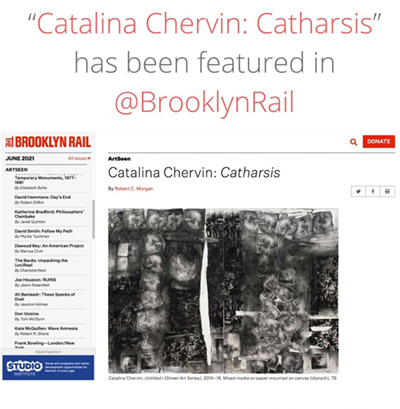Catalina Chervin, Catharsis
Robert C. Morgan (2021)
|
My first acquaintance with the work of Catalina Chervin came in Buenos Aires in 1992, on a studio visit. Because this was my first visit to Argentina, I was not fully aware of the forms of contemporary art that were then being developed in that country. I was surprised to discover that Chervin’s work was primarily focused on works on paper, not objects or concepts, nor large expressionist canvases. Her sources emerged from a style of figurative drawing that appeared, at that time, unrelated to the trendy, politicized art being produced in the northern hemisphere. I was curious to know whether the kind of drawings, prints, and related works Chervin produced emerged from observation of actual figures skilled in posing or if they were figurations that came to her in the course of working. I soon discovered it was a bit of both. Over the years, on future visits to Buenos Aires, it appeared that Catalina’s work was changing, if slowly and with great deliberation. I have always appreciated the fact that her approach to art was deeply considered and often reconsidered. She rejects the notion of jumping from one idea to another. Instead, she takes her time to map out the direction she wants her work to go. In recent years it has become evident that while her work continues to reveal aspects and traces of the figure, the trajectory of its development has increasingly embraced abstraction. This is made apparent in her current exhibition at Hutchinson Modern & Contemporary uptown. The largest work in this show, Untitled I (Street Art Series) (2014–16), is a mixed media work on paper mounted on canvas. From my point of view, this is a major work. Although sometimes described as a diptych, it is perhaps more properly designated a two-paneled painting. A Renaissance diptych is made up of two separate images shown together as one—think of discrete pictures of saints brought together in a single altarpiece. Untitled I, by contrast, is profoundly unified, a monumental image spread across two equally measured surfaces. Hutchinson’s show provides us with the rare opportunity to see such a large-scale work by Chervin in relation to what she does on smaller surfaces. Other mixed media works, such as Portrait I (2009–13) and Portrait II(2006–17) are clearly impressive in their visual inventiveness and formal articulation, but they are less experimental in their approach to mixed media as compared with Untitled I, which functions as a densely ink-saturated painting that holds forth with a particular brilliance. This is not to say the Portraits are less effective in their own right. In all cases, the artist’s manipulation of her materials goes far beyond a mere formal exercise, extending into luminescent caverns of interior space that are a wonder to behold. Another standout in Chervin’s exhibition is her Series of Blots (2018), four works on handmade Khadi papers. In each of these, the artist employs charcoal, pen, pencil, and walnut ink. The ink is used to create “figurative” shapes that might serve as a visual evocation of the body, more specifically an abstract reference to self-portraiture. There is a kind of spiritual warmth that emanates from these works that draws the viewer inward. They represent the kind of experience of abstract form originally intended in the early paintings of both Malevich and Kandinsky. For these artists, individual “feeling” was the necessary counterpart to form. Moving from the personal to the literal, the artist has included three Untitled drawings whose titles identify them as part of the Small Ink - Marks Series. Each of these employs a system of varied marks made using a pen, pencil, and charcoal on Saunders or Lanaquarelle paper. It is clear that these drawings deal closely with the literalness of their materials, but this does not prevent them from having emotional content. The task of reconciling these two potentially divergent impulses has persistently, over time, been the focus of Chervin’s artistic practice. Much to her credit, however, she chooses not to discuss this aspect of her work. In some ways, this might explain her increased involvement with abstract form. Rather than produce a realistic representation of the human figure to evoke an emotional response, her indirect approach is to allow the work to create its own sublimity, untethered in its external references. By taking her imagery beyond the obvious and into the unfathomable, Chervin unremittingly creates art that extends drawing into a form of meditation on her experience of everyday life. From my perspective, there is a certain wizardry in all of this. It is a means of drawing that exceeds so-called “mark-making” by taking the viewer beyond the boundaries of dutifully filling space. At a certain point, the emotional content in her work takes command by extending it into something that might be called universal. She draws the universe of feeling.
|
|
| More essays |
Catalina Chervin
|

